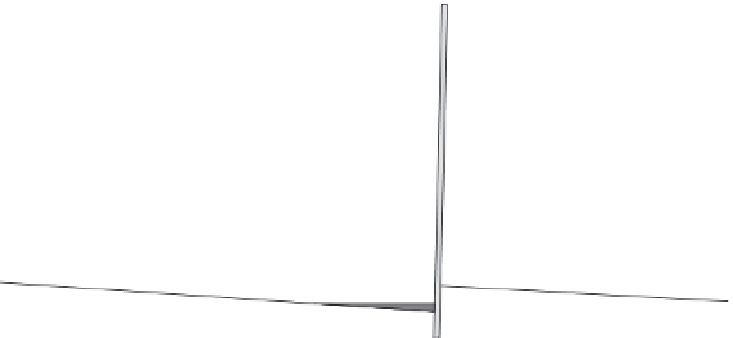Environmental Engineering Reference
In-Depth Information
Infiltration
Figure 9.3
Conceptual
model of water movement
through the unsaturated zone
at Yucca Mountain, Nevada
(after Flint
et al
.,
2001b
).
Arrows indicate direction of
water flow.
Surface
fault
fracture flow
Welded Tiva Canyon Tuff ff
matrix flow
Paintbrush Group
nonwelded tuff
matrix flow
fracture flow
Welded To popah
Spring Tuff ff
perched
water
matrix flow
Nonwelded Calico
Hills Formation
matrix flow
water table
methods for estimating drainage rates through
the unsaturated zone were applied, including
water-budget, Darcy, zero-flux plane, modeling,
and tracer methods (Flint
et al
.,
2002
).
The conceptual model, as of 2000, suggests
an average drainage rate of between 5 and
10 mm/yr, an order of magnitude greater than
original estimates (Flint
et al
.,
2001a
). The con-
ceptual model also indicates that water moves
in different ways through the different layers
in the unsaturated zone (
Figure 9.3
). Matrix
flow predominates in some layers, whereas in
other layers water moves primarily through
fractures. The approach taken in this study is
instructive, and can be replicated at different
scales for other studies - developing a concep-
tual model, using that model to guide data
collection and analysis (including simulation
models), revising the conceptual model, and
repeating the loop.
as focused recharge from streams draining
these mountainous areas. As one example, in
most years, the entire flow from the Big Lost
River in Idaho is lost to infiltration in the Snake
River Plain in the vicinity of Lost River Sinks
(Berenbrock
et al
.,
2007
). Irrigated agriculture is
the main industry; irrigation water is obtained
from both surface and groundwater sources.
Due to the permeable nature of the rocks, irri-
gation return flow, by drainage beneath the root
zone and leakage from water delivery systems,
is an important component of total recharge
(Vaccaro and Olsen,
2007
).
Because of the highly permeable sediments,
water can move quickly from land surface to the
water table, and there are few applicable meth-
ods for estimating recharge. Bauer and Vaccaro
(
1990
) and Vaccaro (
1992
) used a water-budget/
watershed model (the Deep Percolation Model)
to estimate recharge for the entire Columbia
Plateau regional aquifer system. Vaccaro and
Olsen (
2007
) applied the Deep Percolation Model
and another watershed model to the Yakima
River watershed. Annual precipitation in the
watershed ranges from about 175 mm in the
lowland agricultural areas to about 3000 mm
in upland forested areas. Recharge rates prior to
the development of irrigation were estimated to
range from 2 mm/yr to about 850 mm/yr; 97% of
all recharge occurred in the uplands. With the
onset of irrigation, total recharge for the area is
estimated to have increased by more than 30%
9.4.3 Columbia Lava Plateau
The Columbia Lava Plateau is formed by extru-
sive volcanic rocks interbedded with or over-
lain by alluvium or lake sediments. The rocks,
which are very permeable due to tubes and
shrinkage cracks, make highly productive
aquifers. The climate over most of the plateau
is arid to semiarid, but mountains that border
the region to the east and west can receive in
excess of 2000 mm/yr of precipitation. Much
of the natural recharge in the region occurs


























































